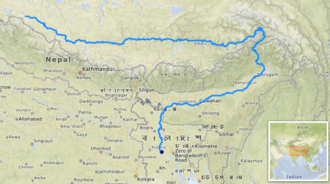Brahmaputra River: Lifeline of Northeast India

Introduction
The Brahmaputra River, one of the major rivers in Asia, holds immense significance for India, particularly in the northeastern region. Spanning about 2,900 kilometers, this river not only supports agriculture and livelihoods for millions but also plays a crucial role in the ecology and economy of the region. The river’s importance has been amplified in contemporary discussions surrounding climate change, river management, and biodiversity conservation.
Geographical and Cultural Significance
The Brahmaputra originates from Tibet, where it is known as the Yarlung Tsangpo, and flows through India and Bangladesh before merging with the Bay of Bengal. In Assam, it is revered as a sacred river, deeply embedded in the cultural and spiritual practices of the local population. The river’s basin is vital for agriculture, providing irrigation to millions of farmers who depend on it for their crops, particularly rice and tea.
Current Challenges
Despite its significance, the Brahmaputra faces numerous challenges, many of which are exacerbated by climate change. Erratic rainfall patterns and glacial melt have increased the risk of flooding, which has devastating impacts on communities along its banks. Additionally, sedimentation and erosion are growing concerns, affecting not only the river’s health but also the livelihoods of those who rely on it.
Moreover, transboundary water disputes with neighboring countries like China and Bangladesh pose significant geopolitical challenges. China’s ongoing dam projects on the upstream portion of the river have stirred concerns in India, as they could potentially impact the water flow and monsoon patterns in the region.
Conservation Efforts
Recognizing the importance of the Brahmaputra, various initiatives are underway to address these challenges. The Indian government, in collaboration with local communities and NGOs, is working on sustainable river management practices aimed at mitigating the effects of climate change. There are efforts to enhance flood forecasting and warning systems, restore wetlands, and promote afforestation along riverbanks to combat erosion.
Conclusion
The Brahmaputra River is much more than a geographical entity; it is a vital lifeline for millions. In light of the challenges posed by environmental changes and human activities, it becomes imperative to adopt a holistic approach towards its conservation. The river’s future holds significance not just for the present generation but also for the ecological health and sustainability of the entire region. As stakeholders from various sectors join hands to protect this invaluable resource, the call for a cooperative approach to river management and conservation continues to grow louder, echoing the very essence of life that the Brahmaputra nurtures.









